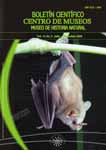Authors
Abstract
This work describes and compares the female reproductive system of Ithomia alienassa (Ithomiinae), Heliconius charihtonia (Heliconiinae), and Actinote equatoria (Acraeinae). Ten females per species were collected; their abdominal region was anatomized for the extraction of their reproductive system. Through optical microscopy, the analysis of the reproductive systems evidenced that both the form and size of the ovarioles vary in each species, as well as the other constitutive parts of their reproductive system, determining the reproductive strategy developed by each species.
References
BUNING, J., 1994. The insect ovary. Ultrastructure, previtellogenic growth and evolution. Londres (Inglaterra): Chapman Hall. 400 p.
HOLDRIDGE, L. R., 1987. Zonas de vida de Colombia. Universidad Nacional de Colombia, Medellín. 121 p.
ROMOSER, W. S. & STOFFOLANO, J. G., 1998. The science of entomology. 4. ed. Boston: McGraw-Hill. 624 p.
SCOBLE, M. J., 1995. The Lepidoptera; form, function and diversity. Oxford: Oxford University Press. 404 p.
SNODGRASS, R. E., 1935. Principles of insect morphology. Nueva York: McGraw-Hill. 667 p.
VALENCIA M., C., 2004. Las mariposas diurnas como indicadores biológicos en el cultivo del café: Tesis de grado de Ingeniero Agrónomo, Universidad de Caldas, Facultad de Ciencias Agropecuarias, Manizales. 165 p.
VALENCIA M., C., GIL, Z. & CONSTANTINO, L. M., 2005. Mariposas diurnas de la Zona Central Cafetera Colombiana. Guía de Campo. Chinchiná, Colombia: Cenicafé. 244 p.
WIGGLESWORTH, V. B., 1950. The principles of insect physiology. Nueva York: E.P. Dutton and Co. 434 p.

 PDF (Español)
PDF (Español)
 FLIP
FLIP


















